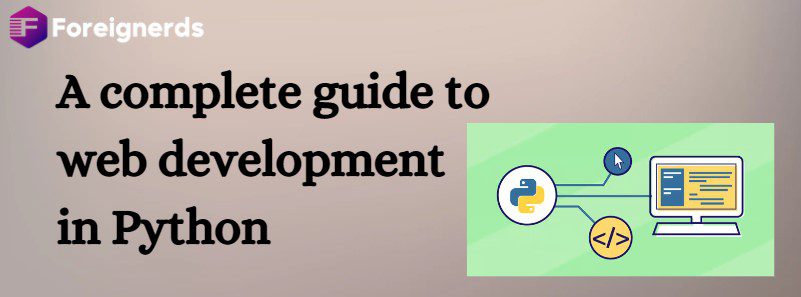- Home
- Website Development & Designing
- A Complete Guide to Web Development...

Python is a versatile programming language known for its simplicity and readability. It has gained immense popularity in the world of web development due to its robust frameworks and libraries. If you’re looking to embark on a journey into the world of web development using Python, you’ve come to the right place. In this comprehensive guide, we will take you through the various aspects of web development in Python, from the basics to more advanced topics.
Before diving into web development, let’s briefly introduce Python and its relevance in this context. Python is an interpreted, high-level, general-purpose programming language. Its clean syntax and vast standard library make it an excellent choice for building web applications.
To start developing web applications with Python, you need to set up your development environment. This involves installing Python, a code editor or IDE (Integrated Development Environment), and any necessary dependencies. You can use Python’s package manager, pip, to install packages and libraries.
Web frameworks are essential tools that streamline web development. They provide a structured way to build web applications, handling common tasks like routing, request handling, and database interactions. Two popular Python web frameworks are Flask and Django.
Flask is a lightweight and minimalistic web framework that is perfect for small to medium-sized projects. It’s known for its simplicity and flexibility, allowing developers to build web applications quickly.
Django, on the other hand, is a high-level web framework that follows the “batteries-included” philosophy. It offers a robust set of features and follows the “Don’t Repeat Yourself” (DRY) principle, making it an excellent choice for large and complex web applications.
A crucial aspect of web development is database management. SQLAlchemy is a powerful and versatile library that allows you to interact with databases using Python. You can use it with both Flask and Django to handle database operations.
HTML and CSS are fundamental technologies for creating web pages. You’ll need to understand these languages to design and structure your web applications.
Web applications often involve forms for user input. Python provides tools and libraries to handle form submissions efficiently.
URL routing is the process of mapping URLs to specific views or functions in your web application. Both Flask and Django offer robust URL routing mechanisms.
Security is paramount in web development. Learn how to implement user authentication and authorization to protect your web applications.
RESTful APIs are essential for building modern web applications. Python provides libraries and tools to create RESTful APIs that can communicate with frontend or mobile applications.
Effective testing and debugging are crucial to ensure your web application works as expected. Python offers testing frameworks like unittest and pytest for this purpose.
Explore various deployment options, such as using cloud platforms or hosting providers, to make your Python web application accessible to users worldwide.
Learn about performance optimization techniques to ensure your web application runs smoothly, even under heavy loads.
Finally, we’ll delve into security best practices to safeguard your Python web application against common vulnerabilities and threats.
Congratulations! You’ve completed this comprehensive guide to web development in Python. By now, you should have a solid understanding of the fundamentals and be well-equipped to start building your own Python-powered web applications. Remember that practice makes perfect, so keep coding and experimenting to refine your skills.
© 2013 - 2024 Foreignerds. All Rights Reserved